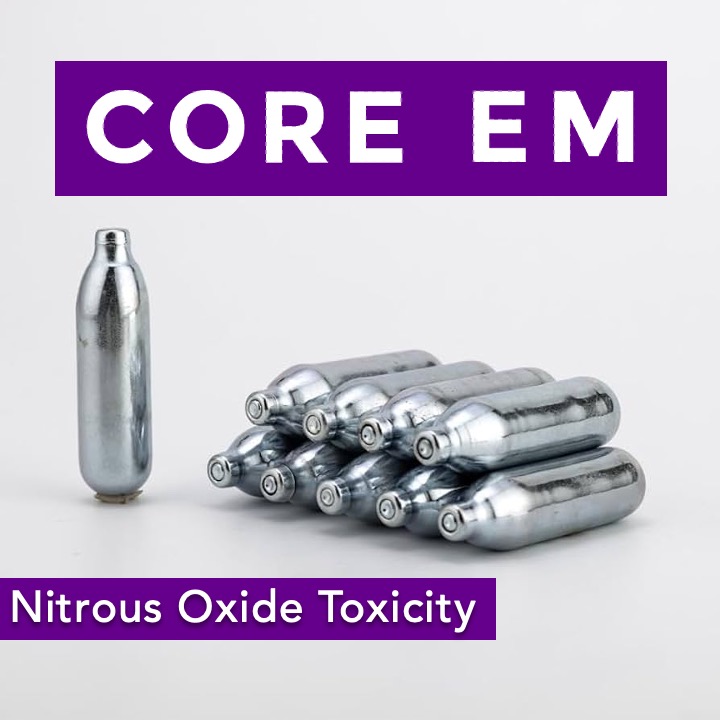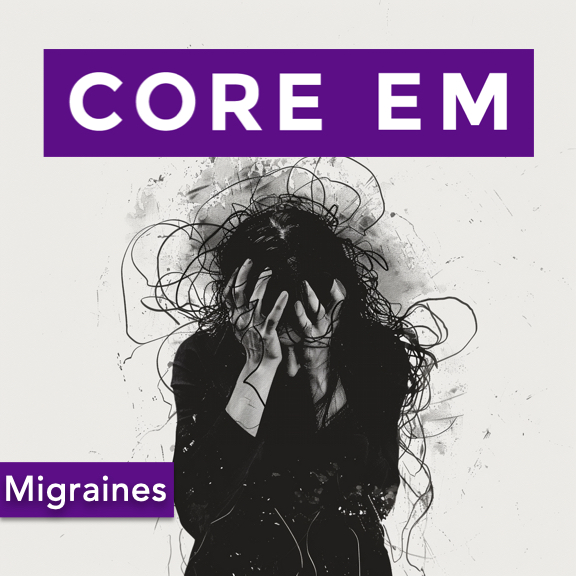Episode 194: Nitrous Oxide Toxicity
Update: 2024-03-01
Description
We review Nitrous Oxide Toxicity: Symptoms, diagnosis, and treatment overview
Hosts:
Stefanie Biondi, MD
Brian Gilberti, MD
Download
Leave a Comment
Tags: Toxicology
Show Notes
Patient Case Illustration
- Hypothetical case: 21-year-old male with no previous medical history, experiencing a month of progressively worsening numbness, tingling, and weakness. Initially starting in his toes and spreading to his hips, and later involving his hands, the symptoms eventually escalated to the point of immobilization. Despite initially denying drug use, the patient admitted to using 40-60 canisters of nitrous oxide (whippets) every weekend for the last three months.
Background and Recreational Use of Nitrous Oxide
- Nitrous oxide, a colorless, odorless gas with anesthetic properties.
- Synthesized in the 18th century.
- Its initial medical purpose expanded into recreational use due to its euphoric effects.
- Resurgence as a recreational drug during the COVID-19 lockdowns.
- Accessibility and legal status.
Public Misconceptions and Health Consequences
- There are widespread misconceptions about nitrous oxide
- Particularly the belief in its safety and lack of long-term health risks.
- Contrary to popular belief, frequent use of nitrous oxide can lead to significant, sometimes irreversible, health issues.
Neurological Examination and Diagnosis
- Key components of the examination include assessing strength, sensation, cranial nerves, and proprioception, with specific abnormalities such as symmetrically decreased strength in a stocking-glove pattern, upgoing Babinski reflex, and positive Romberg sign being indicative of potential toxicity.
Physical Exam Findings: Upper vs Lower Motor Neuron Lesions

Localize the Lesion- Differential Diagnoses for Extremity Weakness
Localize the Lesion- Differential Diagnoses for Extremity Weakness

Localize the Lesion- Differential Diagnoses for Extremity Weakness
MRI Findings and Subacute Combined Degeneration
- The MRI displayed symmetric high signal intensity in the dorsal columns, a diagnostic feature identified as the inverted V sign or inverted rabbit ear sign.
- Significance of the Inverted V Sign: This MRI sign is pathognomonic for subacute combined degeneration, indicating it is a distinct marker for this condition.
- T2 Weighted Axial Images: The inverted V sign is observed in T2 weighted axial MRI images, which are used to evaluate the presence and extent of demyelination within the spinal cord.
- Interpretation of Hyperintense Signals: Hyperintense signals on T2 weighted images generally indicate demyelination, where the protective myelin sheath around nerve fibers is damaged or destroyed.
- Anatomical Location: The dorsal columns, located anatomically dorsal (toward the back) within the spinal cord, will appear toward the bottom of the screen in an axial (cross-sectional) view on the MRI.
- Demyelination Appearance: Demyelination in the dorsal columns, typically situated in the thoracic spine, manifests as an upside-down V shape on the MRI, correlating with the described inverted V or rabbit ear sign.
Pathophysiology of SCD due to Nitrous Oxide
- Nitrous Oxide’s Effect on Vitamin B12: Nitrous oxide inactivates vitamin B12 by oxidizing a cobalt component within the molecule, rendering the vitamin functionally ineffective despite adequate consumption and absorption.
- Impact on Methionine Synthase: The oxidation of vitamin B12 by N2O prevents it from activating methionine synthase, an enzyme critical for important biochemical processes.
- Folate to Tetrahydrofolate Conversion: Inactive methionine synthase cannot convert folate into tetrahydrofolate, which is necessary for DNA synthesis. This disruption can lead to megaloblastic anemia, a condition associated with N2O-induced subacute combined degeneration.
- Conversion of Homocysteine to Methionine: Methionine synthase is also responsible for converting homocysteine to methionine. Methionine is essential for the maintenance of myelin integrity, the protective sheath around nerve fibers.
- Demyelination and Neurological Symptoms: The inability to maintain myelin integrity due to disrupted methionine production leads to the demyelination of dorsal columns and peripheral motor/sensory nerves, characteristic of N2O-SCD.
- Normal B12 Levels with Functional Deficiency: Blood levels of vitamin B12 can appear normal in individuals affected by N2O exposure, as the issue lies in the vitamin’s inactivation rather than its absence, creating a functional deficiency.
- Diagnosis of N2O-SCD: To diagnose N2O-induced SCD, healthcare providers need to check for elevated levels of methylmalonic acid and homocysteine. These substances are typically metabolized with the help of vitamin B12, and their elevated levels indicate a func
Comments
Top Podcasts
The Best New Comedy Podcast Right Now – June 2024The Best News Podcast Right Now – June 2024The Best New Business Podcast Right Now – June 2024The Best New Sports Podcast Right Now – June 2024The Best New True Crime Podcast Right Now – June 2024The Best New Joe Rogan Experience Podcast Right Now – June 20The Best New Dan Bongino Show Podcast Right Now – June 20The Best New Mark Levin Podcast – June 2024
In Channel










